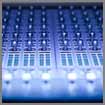 Production Sound Mixing is the complex craft of recording live dialogue and sound effects on the set during principal photography of a motion picture or video. It differs greatly from post-production Re-recording and most other audio recording arts in that the Mixer is no longer the key figure in the operation.
Production Sound Mixing is the complex craft of recording live dialogue and sound effects on the set during principal photography of a motion picture or video. It differs greatly from post-production Re-recording and most other audio recording arts in that the Mixer is no longer the key figure in the operation.
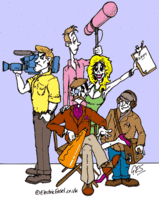 On the set, the Production Mixer is only one of many important craftspeople involved in the making of a film or video. The production company is not out there to shoot an "audio!" Sound must do their thing in harmony with the priorities of camera, lighting, and dramatic direction; and must often take a back seat to these other aspects.
On the set, the Production Mixer is only one of many important craftspeople involved in the making of a film or video. The production company is not out there to shoot an "audio!" Sound must do their thing in harmony with the priorities of camera, lighting, and dramatic direction; and must often take a back seat to these other aspects.
A large percentage of Production Sound Mixers are not bona fide Engineers from an electronics standpoint. Very few Production Mixers possess more than the most rudimentary knowledge of audio circuitry. They know how to operate their equipment, but it is not professionally necessary to be able to perform any sort of extensive repairs. (Technicians back at the sound shop do that.)
What Sound Mixers do have to master, in addition to their own craft, is an understanding of the crafts and techniques adjacent to theirs. One cannot choreograph booms and fishpoles without understanding lighting, lenses, and camera moves.
Creative decisions regarding the soundtrack itself cannot be made without an innate familiarity of the entire editing and re-recording process. For example, knowing when the (bad) sound on a wide master shot can be replaced with the good (though not lipsync) track borrowed from a crisp, close-up.
Set etiquette is very important. Shot numbers must be gotten from the scriptperson (and confirmed with the camera assistant) for keeping accurate logs. Communication chains between talent, director, and camera must be assertive yet not overbearing. And rigging microphones under a shy actress's costume requires the utmost tact.
Filmmaking is a collaborate art! Production Sound Mixing is a part of that.
Staffing
The typical Production Sound Crew consists of two to five persons, two or three being the norm. The Mixer is the key figure and assumes responsibility for the soundtrack and the politics of the department. Side by side with the sound mixer is the Boom Operator. The Mixer and Boom man will often collaborate on determining mic placement. Features and television will have a third person, known as the Utility Sound Tech. Duties of the third person include rigging plant mics and radio mics, wrangling cable on complex moves, or working as second Boom. Scenes being shot to sync playback may require the addition of a skilled Playback Operator, as well.
Why this mention about Crewing? Because the number one cause for good studio engineers falling flat on their faces when asked to go out on a shoot is that they think (or the producer thinks) that one body can do it all. Low budget video shoots are notorious for expecting one-person crews to bring back "Hollywood" finished soundtracks.
The typical duties of a one-person crew include operating the recorder, mixing the incoming mic levels, and holding the boom -- ALL AT ONCE. Sorry folks, it just doesn't work if you're aiming for anything better than an ENG soundtrack.
There are two types of sound that a one-person crew can be expected to successfully achieve: 1) ambience; and 2) talking head.
Imagine the soundperson stuggling to hold a boompole with two hands, while controlling the mic gain (volume) with one hand, and controlling the gain of maybe one or two lavs or radio mics with another hand… Don't know about you, but my count came up short in the niumber of hands needed versus hands available.
If we remove the boom option and just try to use the audio from a camera mounted microphone, even the best condenser shotguns won't discern most dialogue from those (camera) distances. The best that a camera mic can be expected to deliver is general background ambience.
If we keep the boom option, then our sound mixer has to learn to balance the pole in one hand, while trying to control audio levels with the other. Or, ignore all of the levels, and just concentrate on the boom. Either way, it may be good enough for a reality show, but feature quality it is not!
As an alternative, lavalieres can be deployed to capture specific dialogue. However, hardwired lavs are rarely suitable for more than interviews, spokesman standups, or limited drama. Radio mics can provide greater talent mobility, but have the drawbacks of RF interference and dropout. Lavalieres in general may create a problem with audio perspective (the intimate, close-up sound does not match the camera angle) and phasing. There are also the inherent problems of clothing noise and body movement. Wrangling multiple lavaliers is never as easy as Producers imagine. Just ask the editor who has to sort out the mess.
A two-person sound crew would be able, on the other hand, to record all but the most complex dramatic scenes. Because the Boom man is a separate entity, he or she is free to move in close to the sound source and to follow talent, enabling better dialogue recording. The Mixer is now able to divert full attention to mixing the incoming signals. Even when talent is placed on a lav or radio mic, the boom man can round out the track by miking the subtle detail, such as footsteps, hand props, and other natural effects.
It should go without saying that the right tools are a necessity for doing a good job.
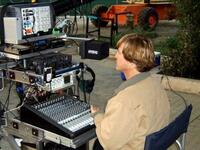
The recorder is a portable digital recorder, two or more tracks, and often with timecode. On feature films, it is not uncommon to see two recorders on the soundcart: a multi-track deck for recording isolated tracks; and a simpler two-track recorder for dailies and the picture-cut. Sometimes a soundtrack may be simultaneously recorded in the video camera. Always try to monitor out of the record deck rather than the mixing panel, in case of RF interference or ground loops.
The mixing panel is of paramount importance. On a set, it is not so often a question of mixing a large number of inputs as it is being able to exert control over one or two. A good panel should offer four to eight inputs (rarely will you ever need more than that), limited equalization, lots of input gain, and a communications module.
EQ is hardly used, except for bass roll-off and a slight mid-range boost to help punch the dialogue. Anything more than that is best achieved during post-production. Signal processing does not belong on the set; it should be done later on in the 'million dollar rooms" during final re-recording. Films are shot out of sequence, with shots being torn apart and edited together to create finished scenes. Attempts to prematurely process the track can cause a myriad of matching problems.
Much of production mixing consists of riding gain on a mic, leveling out the extremes of each character as well as balancing between multiple characters. Smooth ramping or slope is essential in a pot or fader to accomplish this feat inaudibly. Most of the compact sized ENG-style mixing boxes fall short for this function. Not only are their mini-knobs too small for human fingers, but even slight gain adjustments call attention to themselves on the track.
In terms of the communications module, a mixing panel should have a slate mic (possibly with sub-tone slating if one is working in film), a talk-back for communication with the boom man during a take, audio returns for the boom men, and a 1-K tone oscillator for setting reference levels.
If you are working in video, then be very cautious of all electrical connections (VTR, monitor, and camera) that may cause ground loops and induce noise into the track. (Note: electrical interference can be induced via BNC video connectors; not just power or audio.)
Microphones should be of true condenser type, 48v Phantom. Good shockmounts and blimp-type windscreens are a must. Patterns should include a long shotgun, a short shotgun, and a wideer angle cardioid. Avoid being saddled with the less expensive, electret condenser capsule systems that are so much in vogue with the video people. These systems, though wonderful for their price, lack the sensitivity and reach offered by "real" condensers.
Lavalieres come in two basic varieties, transparent or proximity oriented. In the old days, all of your professional grade electret lavalieres were proximity oriented. That is, they tended to add presence to close dialogue while rejecting background ambience -- which was fine for newscasters and spokesman. Many of the newer mini-lavalieres offer a more transparent sound, allowing them to blend in more naturally with overhead boom mics or to function as plant mics. The drawback is that the transparent lavs also pass more ambience. Depending on the situation, both varieties have their uses.
Radio mics are an option. They are expensive, and even the best of them can be unreliable due to outside factors (such as RF interference, magnetic voodoo, etc.). However, there will be instances when the sound is either gotten off of radios or not at all. If you plan on needing radios, budget for more units than what you expect to use. Otherwise, what do you do if a unit breaks?
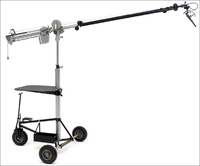 Boompole selection is very important. They should extend to 12 or 18 feet. A pole should be lightweight, but not to the point of bowing under the weight of a mic, shockmount, and windscreen at full extension. Struggling all day with a bending boompole will wreak havoc on a boom man’s back. Also, make sure that the locking mechanisms and internal mic cable does not rattle when the pole is moved. There is a reason that good boompoles are expensive.
Boompole selection is very important. They should extend to 12 or 18 feet. A pole should be lightweight, but not to the point of bowing under the weight of a mic, shockmount, and windscreen at full extension. Struggling all day with a bending boompole will wreak havoc on a boom man’s back. Also, make sure that the locking mechanisms and internal mic cable does not rattle when the pole is moved. There is a reason that good boompoles are expensive.
Studio booms, such as the Fisher, are actually rather inexpensive to rent and should be seriously considered for many non-documentary productions. Their ability to telescope over distances and cue make them highly versatile on a set. Budget extra, though, for an experienced boom operator to run it.
Priorities
As mentioned before, Production Sound is an art of compromise on the set. Dialogue is recorded with Picture, and both must give way a little bit.
The job of the Production Mixer is to record raw material for the editors and re-recording mixers to transform into a finished soundtrack.
Therefore, the first priority is to get the Dialogue any way possible that would be usable. In the event that laying down usable dialogue is impossible, then one should still try to get as near perfect a track anyway, even if it is only to be used as a guide track for ADR (looping).
Second priority would be to record the Dialogue in matching perspective for the camera angle. What the audience sees is essentially what they should hear. For example, a person walking away from the camera should not get louder (just because the actor is moving closer to a hidden mic in the back of the set). A close-up should not be louder than the medium shot, since all that has changed on-screen is the camera angle, not the distance from audience to actor.
The final priority is to record Sound Effects to accompany the shot. This might include such things as footsteps, hand props, doors, etc. Sometimes this is recorded during the actual take, during a rehearsal, or after the shot. Some productions may also ask for Presence (room tone).
Hint: If you are requested to record Presence, arrange to do it just before the camera roll of the first take. That way, everyone is in position and the sound will be an exact match of the actual take. Waiting until the end of the last take results in having to fight the commotion of exiting talent, crew, and wrapped equipment. Room tone recorded in an empty set is hollow and would not easily intercut with the actual take. Room tone is intended as emergency filler that the editor can splice into a live scene in order to replace unwanted noise. It should be an exact match for the dialogue scene: same mic, same angle; same volume setting -- just no dialogue.
Recording sync sound effects can be the most trying from a political standpoint. Editors like sound effects, but on isolated tracks. Producers, on the other hand, are impressed by sync sound effects on the main track during the screening of dailies. Production Managers hate anything that slows up the pace of things on the set, even if it would save money later.
It is essential to determine how the show is going to be handled from an editorial standpoint. For instance, somet non-theatrical video productions may not have a budget for extensive audio sweetening, other than to lay in some music, narration, and a few key sound effects. In that situation, a good mixer might try to pack the track with as much texture and live sound effects as necessary, without endangering either the clarity of the dialogue or the ability to intercut shots. On the other hand, a feature film editor would prefer a "clean" soundtrack that can be embellished on the cutting bench.
The Hierarchy of Microphone Techniques
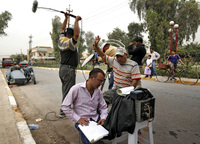 There are four basic ways to approach miking a subject: boom; plant; lavaliere; or radio mic.
There are four basic ways to approach miking a subject: boom; plant; lavaliere; or radio mic.
In most instances, the best dialogue will be achieved by employing a boompole overhead of the subject. A good condenser shotgun mic, angled a couple of feet and slightly ahead of the subject will produce a crisp, natural tone. The sound will not be affected by clothing noise or bodily movement (such as arms folded across the chest). Talent can move around, walk, sit, etc. -- with the mic following overhead. Multiple performers can interact with each other, both verbally and physically, without rustle or phasing problems.
In a pinch, the boompole can be held at knee level with the mic pointing up. There may be a resulting slight increase of bass, but that is easily corrected on the mix panel or later on in post.
There is no difference (to the mic) between a boompole that is not moving and a C-clamp. Fixed microphones, also known as plant mics, can be strategically deployed around the set to cover isolated characters that would be impractical to reach with the boom.
Plant mics can consist of either regular condensers or suitable lavalieres. The new mini-lavalieres, with their great sensitivity and transparency, make excellent plants. They are so tiny that they can be hidden right in the middle of the scene and not show up on camera.
Plants can be hidden in doorways, on executive pen sets, on the edge of dressing mirrors, bed headboards, automobile sun visors, even in floral arrangements!
Employ shockmounts to avoid noise and vibrations from being directly conducted to the mic. On lavalieres, a small loop of tape works nicely.
Pay strict attention, though, to multiple mic phasing. A plant and a boom overlapping can easily result in mush, unless you keep your hands busy on the pots.
Lavalieres are the next option. Worn on the body, they tend to go (or stay) where the actor is. As mentioned earlier, the proximity oriented mics (e.g. Sony ECM-55 & ECM-44) tend to add presence to the dialogue as well as to reject background noise. Transparent sounding lavs (e.g. Sony ECM-77b, Audio Technica AT899, Sennheiser MKE-2) blend better with overhead condensers and sound more natural or less "forced." On the other hand, they do not screen out background ambiance as much.
If the actor is going to be walking, and a cable dragging from his or her ankle is impractical, then radio mics are the final resort.
Selecting Overhead Microphones
Which pattern of condenser is best? Like everything else, it depends on the situation.
Narrower patterns, such as shotguns, have greater reach but exhibit more reverberation in a closed interior. For that reason, shotguns are preferred for exterior use or sometimes for use in a very dead soundstage. Besides a build-up of echo in an interior, a shotgun used overhead tends to be physically unwieldy in terms of headroom. Their narrow pattern also makes cueing from actor to actor very critical.
Shotguns, like telephoto lenses, will compress the background in terms of the foreground. In a photo, a distant sunset will appear very large and very close to a foreground sailboat. Similarly, shotguns will magnify background sounds and ambiance in relation to the subject. That is why the best way to utilize a highly directional microphone is with nothing behind the subject (i.e. the mic looks down at the subject, "seeing" only quiet dirt past it; or aimed upwards at the subject, seeing only silent sky). Aiming a shotgun horizontally should be avoided, except for miking certain sound effects.
Wider pattern condensers (cardioids) provide the mellowest sounds in terms of reverberation or room echo, but also have the shortest effective range. They must be kept relatively close to the actors in order to isolate the dialogue. However, since the cardioids are often used in cramped interiors with low ceilings, excessive head room is not usually a problem!
In between the wide cardioids and the narrow shotguns are the wide hypercardioids and the narrower hypercardioids. Their selection would be a trade-off between mellowness versus effective reach.
In addition to echo and reach, another factor that comes into play when selecting a boom mic is that of spread. Scenes involving tricky blocking and/or multiple actors might be better served by a mic that does not require as critical a targeting, even though it would be a compromise against reach and punching the dialogue.
One very useful trick in balancing a strong voice against a weak voice is to take advantage of the microphone's natural pattern. Favor the weak voice on axis, and let the strong voice strike slightly off axis.
A word about wind noise. Foam slip-on windscreens should always be used on interiors, since condensers are sensitive to even the most minute air movements. Out of doors, use a blimp style windscreen (Rycote, K-Tek, Rode, Sennheiser). Wind tends to gust unexpectedly, and simple foam is ineffective against anything more than a wisp of a breeze. For occasional exterior use, the new breed of hybrid slip-on fur over foam windscreens is an economical compromise.
Handheld microphones (performer or reporter mics) aren't used very frequently in theatrical production, but can have their uses. Dynamic mics are ideally suited for recording loud explosions, since their elements are virtually indestructible. A dynamic mic used relatively close-up (6 to 9 inches away) works excellently for isolating speech from a noisy background, such as for on-site voiceovers or talking head (mic seen on camera).
Staged scenes involving the use of a handheld mic (as a prop) should be recorded exactly that way, "as a prop!" Use a boom mic to actually record the voice, unless you want to be at the mercy of handling noise and inconsistent mic placement.
For man-on-the-street reporter interviews, provide talent with an omni-directional condenser (or electret) microphone. That will give you some consistency, irregardless of how well the reporter pays attention to cueing the microphone between himself and the interviewee.
Using Lavaliers
Correctly rigging body mics on talent requires time and tact. For at some point during the process, the soundperson will have to work inside of talent's clothes.
The microphone capsule itself can be secured either outside of clothing or hidden under wardrobe; the cable and connector will almost always be routed under wardrobe.
If the mic is going outside of clothing, then mounting clips can be used. The proper technique for using the tie-clasp style clip involves looping the cable from the head of the mic, like a "J," through the bend (hinge) of the clip. The cable continues up and around --behind the garment -- to complete the circle. As the cable makes its way down, it is clenched in the jaws of the clasp, thus providing a strain relief.
The remainder of the cable is run behind clothing so that the XLR connector can be secured at a convenient point, such as at the waist (belt or pocket) or ankle. Regular mic lines can then be easily connected or disconnected so as to free up talent in between takes.
If needed, the external lavaliere can be made quite inconspicuous by camouflaging it to match wardrobe. Colored marking pens can be used on small strips of tape and/or foam windscreens to subdue the appearance of the mic head and clasp. Alternatively, small patches of felt or cloth can be used to cover the mic. Remember that the (camouflaged) mic will be so tiny in the frame during a medium shot as to be nearly invisible. On close-ups, the camera can frame the microphone out completely.
A useful trick is to save the foam-tipped tech swabs used for head cleaning. These foam booties make excellent, expendable windscreens for mini lavalieres.
Hiding a lavaliere completely under clothing requires a lot more care and attention.
There are two types of clothing noise that one can encounter: contact and acoustic.
Contact clothing noise is caused by a garment flapping into or rubbing across the mic capsule. The solution is to carefully immobilize all clothing that may create this problem, by taping down everything on either side of the mic. One popular technique is to sandwich the mic in between two sticky triangles of tape (formed by folding a strip of tape like a flag, sticky side out).
Contact noise can also be caused when clothing rubs against the mic cable, so care should be taken in this area also -- even for external lavalieres. Form a loop near the mic for strain relief, and then apply a few lengths of tape to along the cable. Use double faced tape or sticky triangles to immobilize clothing as necessary, to keep it from rubbing.
Acoustic noise is that created from clothing rubbing against itself and generating a sound. Static Guardtm works well against this. A light spray of water can help soften starched fabric. Synthetic fibers tend to be much noisier than naturals, so they should be avoided whenever possible.
Rigging radio mics is a complex art in itself, but the most important point to remember is to never allow the mic line and the antenna to cross. Also, the antenna should be kept somewhat rigid, and never looped over itself. If the antenna has to run in a direction other than straight up or to the side, flip the transmitter unit around. (It is okay for the mic line to loop around, though.) A good way of keeping the antenna rigid is to affix a rubber band to the tip, and then to safety pin the rubber band to the clothing. This maintains a little tension but still provides a safe strain relief if the actor should bend over.
Check talent regularly. Tape tends to loosen due to moisture and movement. Costumes tend to be adjusted constantly, either by talent themselves or by the costume department.
Never assume that wardrobe personnel know how to rig either lavalieres or radios. Consult with them in terms of costume selection or modification so as to facilitate microphone and/or transmitter placement, but do not leave the actual wiring up or readjustments to them. Costumers worry about how the actors look, not how they sound.
Sync Playback
The key word here is sync. To have performers dance and mouth lyrics beat for beat with a prerecorded track requires 100% sync at all production and post-production levels.
A master soundtrack is created, and recorded with timecode. This track will generate the final version soundtrack that will be used by the editor in the finished product. Generated from this (final version) soundtrack will be two or more playback dupes, for use on the set.
On the set, the playback dupe is played back off of a digital recorder or computer. Do not use standard audio CD's as your playback source; their playback speed can be varied. The track is either amplified through a speaker system or silently broadcast to the performers via induction loop cueing. The camera films at crystal sync, sound speed or in dgital video. Timecode information from the playback track is displayed to the camera via a timecode clapstick slate.
Later on, in post, the editor can use the timecode slate reference to match up the picture footage with the corresponding location on the master soundtrack. Note that if the camera speed is 24 fps or true 24p video (not 23.976 which video sometimes calls 24p), then the soundtrack will be out of sync by one tenth of one percent. To deal with this problem, the playback track must be pulled up (speeded up) so that the playback speed of the music, on the shooting set, is actually one tenth of one percent faster than the master soundtrack that will be used in editing. Some playback recorders can do this on the fly; otherwise it must be done in the studio when the playback dupes are created.
If the video camera runs at 29.97 or even 23.976, then it becomes a real-time playback situation and does not require any pull-up on the set.
Moral of all of this: Do not attempt to be in charge of audio on a sync playback shoot until you get some real experience; and always consult carefully with post-production before you shoot so that you can determine what settings to use.
In conclusion
Production Sound is not an endeavor to be taken lightly. Electronic knowledge and a mastery of studio (music) techniques are not qualifications in themselves for successfully mixing dialogue on a shooting set. Life in the Recording Studio is based on achieving excellence under controlled conditions. Mixing on a Production Set is a matter of generating usable raw material, in what are usually uncontrollable conditions.
But with the right approach, equipment, and trained personnel -- a Production Mixer can achieve excellence.
